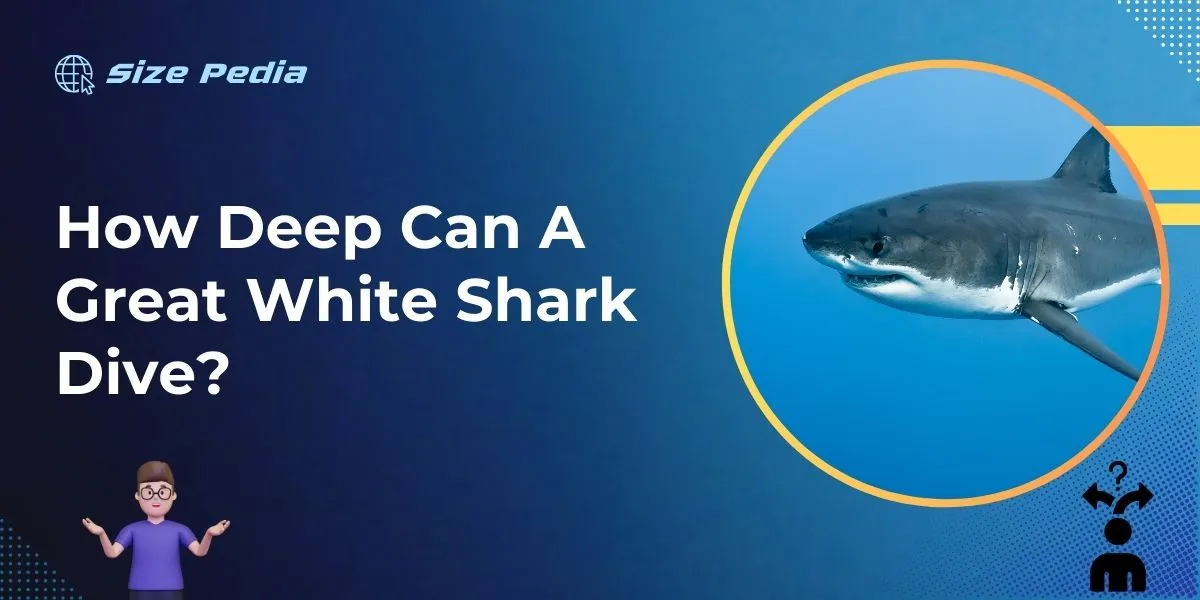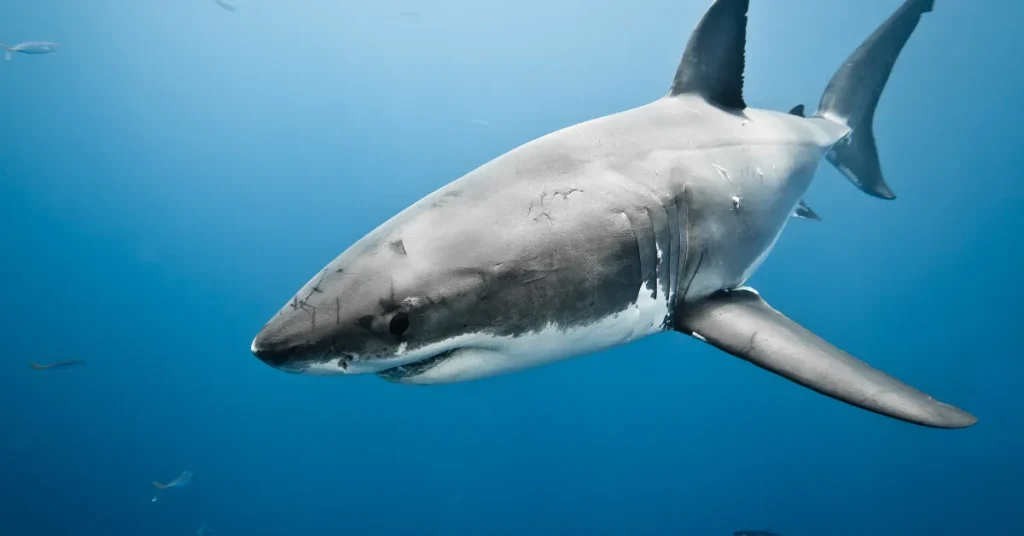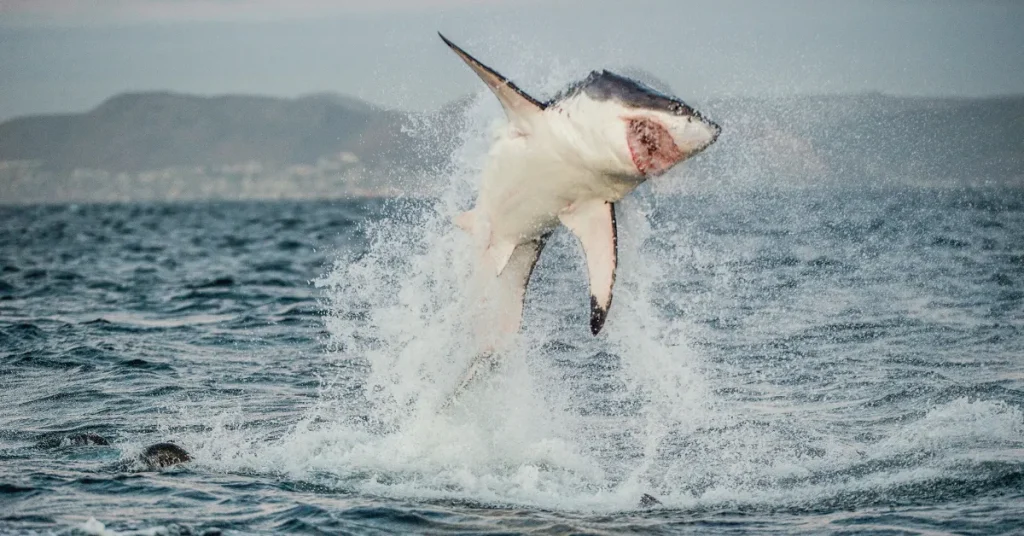A Great White Shark can dive up to depths of around 1,200 meters (3,937 feet). Their diving prowess is vital for hunting and navigating the ocean’s depths.
The Great White Shark, a marvel of marine evolution, possesses an astounding ability to explore the ocean’s profound secrets.
Renowned for its role as an apex predator, the Great White’s diving capacity allows it to cover a wide range of habitats, from coastal shallows to the deep blue.
Diving deep is not just about predation; it also enables these sharks to regulate their body temperature and find prey.
Researchers continue to study these magnificent creatures, utilizing satellite tracking technology to uncover their mysterious deep-sea behaviors.
The more we learn about the Great White’s diving habits, the closer we get to understanding the complexities of marine ecosystems and the crucial role these sharks play in maintaining their balance.

Unmasking The Depths: Great White Shark Diving Capabilities
Imagine a creature of the ocean blue, plunging into the abyss where light dares not reach. The Great White Shark, a marine marvel, is such a creature.
These sharks dive to incredible depths, a fact that captivates scientists and ocean lovers alike. Let’s dive into the capabilities that allow these predators to rule the deep.
Physical Adaptations For The Deep
Great Whites are built for deep-sea exploration. Their bodies have unique features that make deep diving possible.
- Buoyant Liver: Their large livers are full of oil, which helps with buoyancy.
- Dynamic Body Shape: Their torpedo-like structure allows them to slice through water with ease.
- Powerful Muscles: Muscles, rigged for endurance, let them swim great distances, even to the depths.
- Specialized Blood Vessels: These vessels conserve heat, keeping vital organs warm in the cold depths.
Together, these adaptations allow the Great White to conquer the ocean’s depths.
Recorded Dive Depths And Insights
Scientists have long studied these impressive creatures, unearthing fascinating data on their diving habits.
| Depth (meters) | Insight |
| 0 – 200 | Common hunting range, where sunlight reaches. |
| 200 – 800 | Less common, potential feeding or navigation. |
| 800 – 1200 | Rare, extreme dives for specialized prey or conditions. |
The deepest recorded dive of a Great White was an astonishing 1,200 meters deep! Such dives showcase their exceptional abilities and adaptability in oceanic environments.
The Science Of Great White Shark Dives

Great White Sharks are famous for their size and strength.
But their ability to dive deep into the ocean is equally astounding.
Scientists have studied these giants to understand how they manage such feats.
How Pressure Affects Shark Physiology
Deep down, water pressure increases substantially.
This can affect marine creatures greatly.
For the Great White Shark, however, their bodies adapt seamlessly.
- Organs can handle high pressure.
- Blood flow changes to protect their internal systems.
Buoyancy And Temperature Challenges In The Deep Sea
Buoyancy becomes a challenge in the depths of the ocean.
Great Whites are well-equipped to manage this.
- Their liver contains oil that aids buoyancy.
- A unique network of blood vessels keeps them warm.
Temperatures plunge as sharks dive deeper.
Their bodies can withstand cold that would immobilize others.
Great Whites Vs. The Abyss: Comparative Behaviors
Great Whites vs. The Abyss: Comparative Behaviors explores the mysterious depths where Great White Sharks roam.
These apex predators are known for patrolling the shallows, yet their behavior in the inky depths remains intriguing to ocean enthusiasts and scientists alike.
We dive into how these sharks adapt their hunting strategies and interact with deep-sea creatures as they journey into the abyss.
Hunting Strategies At Different Depths
Great White Sharks are strategic hunters, employing different tactics based on the depth they are operating in.
- Shallow Waters: They utilize surprise attacks from below.
- Mid-Water: They rely on keen eyesight to spot prey.
- Deep Dives: Here, they exhibit patience, slowly stalking their target.
A detailed exploration of each zone reveals varied prey choices and attack methods. Agile seals are targeted in shallows, while deeper down, larger fish or scavenged carcasses become the focus.
Interactions With Other Deep-sea Creatures
In the abyss, Great Whites encounter specialized deep-sea dwellers.
| Depth (meters) | Sea Creature | Interaction Type |
| 0 – 200 | Squid | Predatory |
| 200 – 1000 | Gulper Eel | Observational |
| 1000+ | Bioluminescent Fish | Unknown |
Great Whites may assert dominance or exhibit curiosity. Their encounters with creatures like giant squid or ping-pong tree sponge add to the complexity of the deep-sea ecosystem.
Tech And Tracking: Studying Shark Diving Patterns
Tech and Tracking: Studying Shark Diving Patterns are crucial for understanding how great white sharks navigate the vast and deep ocean.
With the latest technology, scientists can now track these incredible predators in ways never before possible. This insight opens a world of knowledge about their behaviors, habitats, and the mysteries of their deep-sea journeys.
Role Of Satellite Tagging In Deep-sea Research
Satellite tagging stands as a revolutionary tool in the study of great white sharks. It allows researchers to follow sharks over vast distances and to record how deep they dive. Here’s how it works:
- Tags attach to a shark’s dorsal fin.
- Tags transmit data to satellites when sharks surface.
- Data received includes locations, depth, and water temperature.
The use of satellite tags has revealed that great white sharks can dive down to 1,200 meters (3,937 feet). This data shows us that great whites are not just coastal predators but also deep-ocean explorers.
Analyzing Dive Data For Conservation Efforts
Through the analysis of dive data collected by satellite tags, scientists can make informed decisions for shark conservation. Let’s look at the importance of this data:
- It helps identify critical habitats for protection.
- Scientists can track shark migration patterns.
- The data is essential for creating marine protected areas.
By studying the depths to which great whites dive, we can ensure their survival. Conserving these deep-dive areas is key to the health of shark populations.
Mysteries Unfolding: Unknowns In Great White Dive Research

In the realm of marine mysteries, the depths to which great white sharks can plunge remain a topic of fascinating research.
Scientists tirelessly work to unravel the secrets of these majestic predators beneath the waves. However, despite modern technology, much remains unknown about the profound journeys that great whites undertake into the ocean’s abyss.
Challenges Of Deep-sea Shark Research
Exploring the deep-sea habits of great white sharks is a daunting task for researchers. Limited access to their remote habitats and the need for specialized equipment make collecting data no easy feat.
Tracking devices must withstand extreme pressures, and locating tagged sharks in the vast ocean can be like finding a needle in a haystack.
- Extreme pressures and depths
- Lack of real-time data transmission
- High costs and technical challenges
Implications For Understanding Oceanic Ecosystems
Discovering the depths of great white sharks’ dives has profound implications for oceanic ecosystems. These apex predators play a crucial role in marine environments. Knowledge about their dive patterns can help protect ocean biodiversity.
| Dive Depth Impact | Research Benefit |
| Food chain insights | Understand predator-prey dynamics |
| Habitat conservation | Inform marine protected areas |
FAQs About How Deep Can A Great White Shark Dive
How Deep Can Great White Sharks Typically Dive?
Great white sharks are remarkable divers, reaching depths up to 1,200 meters (3,937 feet). Their dives vary with hunting and migration, often staying within the top 10 meters during dawn and dusk for feeding.
What Is The Average Diving Depth Of Great Whites?
On average, great white sharks dive to around 300 meters (984 feet). However, their diving behavior fluctuates daily and seasonally, primarily driven by prey availability and environmental conditions.
Why Do Great White Sharks Dive So Deep?
Great white sharks dive deep primarily for hunting purposes. They exploit the depth range to surprise prey from below and to access different prey species that reside at varying ocean depths.
How Long Can Great White Sharks Stay Submerged?
Great white sharks, being highly efficient predators, can stay submerged for up to an hour. Their physical adaptations enable them to take advantage of deep waters without frequent surface visits.
Conclusion
Great white sharks amaze us with their deep-sea escapades. They can plunge to depths well over 1,200 meters. This ability allows them to hunt and navigate vast ocean terrains.
Understanding these depths reveals more about their mysterious lives. Let’s continue uncovering the secrets of these ocean giants.
Resources:
1. https://www.voanews.com/a/biggest-great-white-shark-on-record-thrills-divers-off-hawaii/4748447.html
2. https://www.fisheries.noaa.gov/species/white-shark
